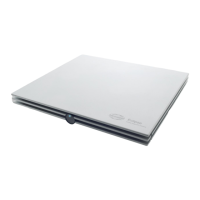Eclipse Additional Information Page 67
3.10.2 Placement of bone conductor
When testing with the bone-conductor, stimulus artifacts will be present at intensities near maximum output.
Reduce the artifact by placing the electrode on the front of the earlobe instead of mastoid position. Placing
the bone conductor too close to the electrode causes artifact and more noise in the recording. A good rule of
thumb is to keep the electrode and bone-conductor minimum 1 cm apart from each other.
Mastoid is preferred as it is 30dB more sensitive than forehead
2
. Consider bone conductor location before
applying electrodes. Place Mastoid electrode below bone conductor for the largest ABR response but not on
the neck muscle.
BC placement on the temporal bone slightly posterior to the upper part of the pinna gave similar ASSR
thresholds to a placement on the lower mastoid.
3
Most bone conductor headbands are too big to fit the head of an infant. Hand-holding the bone conductor
can be used for the mastoid position. Firmly hold the bone-conductor with a finger on the infants head.
Experiments on an artificial mastoid showed differences of less than 1dB in stimulus level between finger
pressure and standard force of 5N.
Do not use two fingers as this reduces the stimuli level. Make sure not to touch the pinna with the bone-con-
ductor or the surface electrode.
Start testing at moderate level (e.g., 30dB nHL). A higher intensity might wake up the sleeping infant.
3.11 ABR Masking
As in Pure Tone Audiometry, problems occur with conductive hearing losses, where cross-masking can oc-
cur.
Differences between ipsi and contralateral waveforms are used to identify the side of the response
Two approaches to detect the hearing ear.:
(a) Presence or absence of wave I (CE-Chirps® helps to give larger amplitudes also wave I which is an indi-
cation of the stimulated ipsi ear is responding).
(b) Asymmetry between ipsi and contralateral recordings, earlier latency and larger amplitude on the side
generating the response.
If a contra response is found, masking should be applied.
An ABR threshold can be masked to ensure that the threshold level is not overheard. The easiest way to ap-
ply masking during a measurement is to stop the measurement or wait until the current recording is com-
plete.
Masking on new-borns and children should be applied when the interaural hearing difference between right
and left ear exceeds:
• Insert phones = 60-70dB nHL
• Headphones = 40dB nHL
• Bone = 15dB nHL
Masking bone, studies indicate an inter-aural attenuation of 20 to 30dB, probably no need to mask at or be-
low 15dBeHL.
If response seen at 15dBeHL then it must be from the ipsilateral ear. If right ear and left ear thresholds are
no more than 15dB apart (10dB at lower frequencies) then no need to mask.
4
2
http://hearing.screening.nhs.uk/
3
Small, Hatton & Stapells (2007)
4
http://hearing.screening.nhs.uk/

